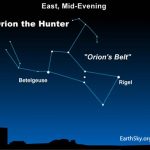
Tonight, watch for Orion the Hunter, perhaps the easiest to identify of all constellations, with its three medium-bright Belt stars in a short, straight row. By mid-to-late November, famous Orion is back in the evening sky, rising at mid-evening (about midway between your local sundown and midnight). It’s around late November and early December that casual skywatchers will begin to notice Orion and to comment on it. You can find this constellation and watch it for months to come.
Plus there’s a binocular comet in the sky – within Orion – that you might be able to glimpse. It’ll be closest to Earth on November 14, 2020. Read more about Comet C/2020 M3 (Atlas).
The most noticeable part of Orion is Orion’s Belt. These three stars in a row aren’t the brightest in the sky, but they’ll catch your eye. As seen from mid-northern latitudes, Orion appears to be lying on his side – with his Belt stars pointing upward – when he first ascends into our eastern sky in mid-evening at this time of year. Orion’s two brightest stars – Betelgeuse and Rigel – shine on opposite sides of the Belt.
EarthSky 2021 lunar calendars are available! They make great gifts. Order now. Going fast!
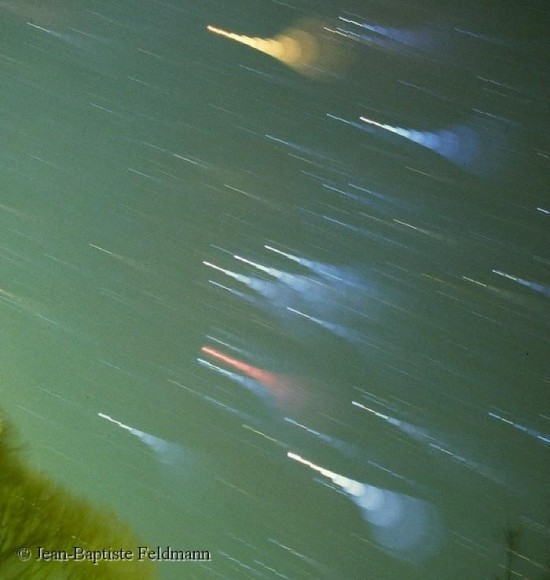
Stars trails of constellation Orion via EarthSky Facebook friend Jean-Baptiste Feldmann. Can you pick out the three stars in Orion’s Belt? Notice also the different colors of the stars in Orion.
As night passes, and Earth spins beneath the sky, Orion will climb higher in our sky. When this constellation is highest in the south, it is a huge, noticeable star pattern. But Orion doesn’t reach its highest point until an hour or two after midnight (that’s local time, for all times zones around the world) in mid- to late November.
Like all the stars, Orion’s stars rise some four minutes earlier with each passing day, or about two hours earlier with each passing month. If you see Orion shining in the east at 9 p.m. tonight, look for Orion to be in the same place in the sky at about 7 p.m. a month from now. Or if Orion is due south at 2 a.m. tomorrow, look for Orion to be due south at midnight one month later.
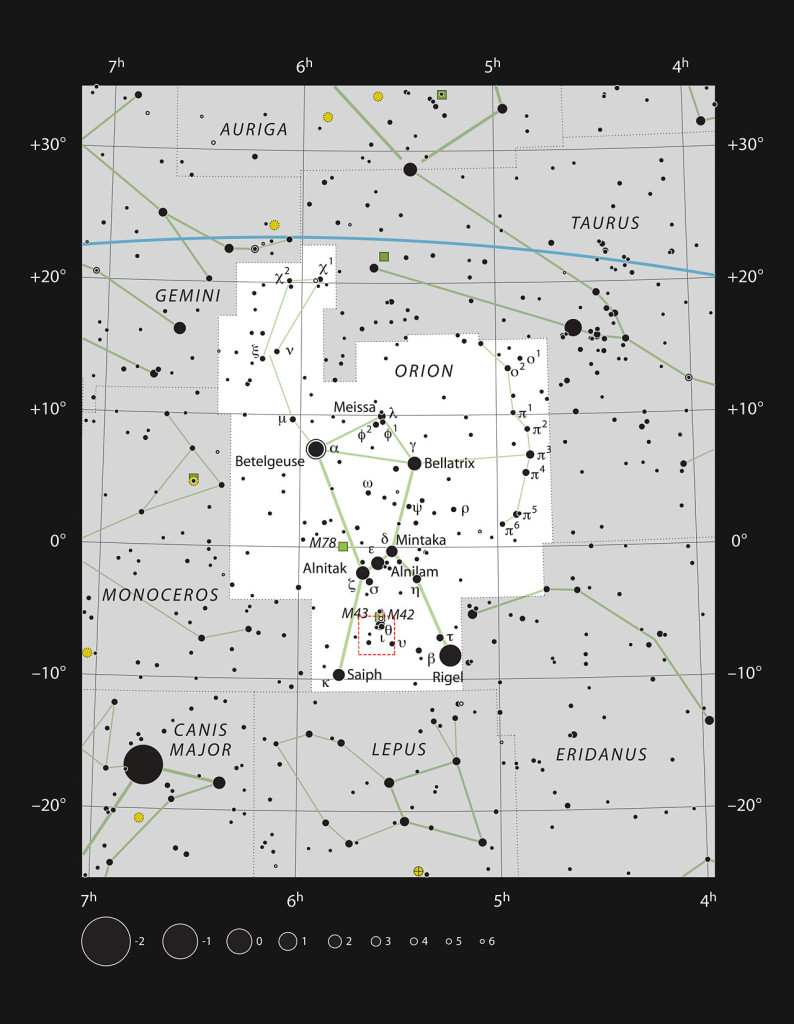
This chart shows the famous constellation of Orion the Hunter. From northerly latitudes in the Northern Hemisphere, Orion stands upright in the southern sky (as pictured above) when this constellation reaches its highest point for the night. From temperate latitudes in the Southern Hemisphere, however, Orion is seen “upside-down” in the northern sky when the Hunter reaches its highest point for the night.
This shift in Orion’s location is due to Earth’s movement in orbit around the sun. As we move around the sun, our perspective on the stars surrounding us shifts. At the same hour daily, all the stars in the eastern half of the sky climb up a bit higher, whereas all the stars in the western half of the sky sink a bit closer to the western horizon.
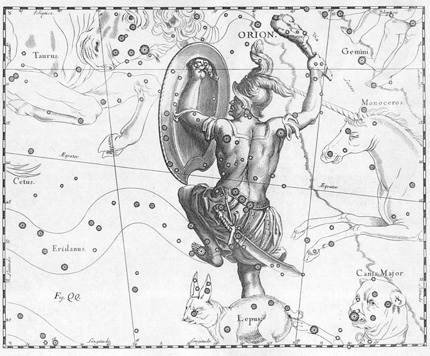
Mirror view of Orion the Hunter from Johannes Hevelius' Uranographia (1690).
Are you familiar with the W- or M-shaped constellation Cassiopeia the Queen? Or Polaris, the North Star? As Orion rises in the east this evening, look for Cassiopeia to soar to her highest point for the night, above Polaris in the northern sky.
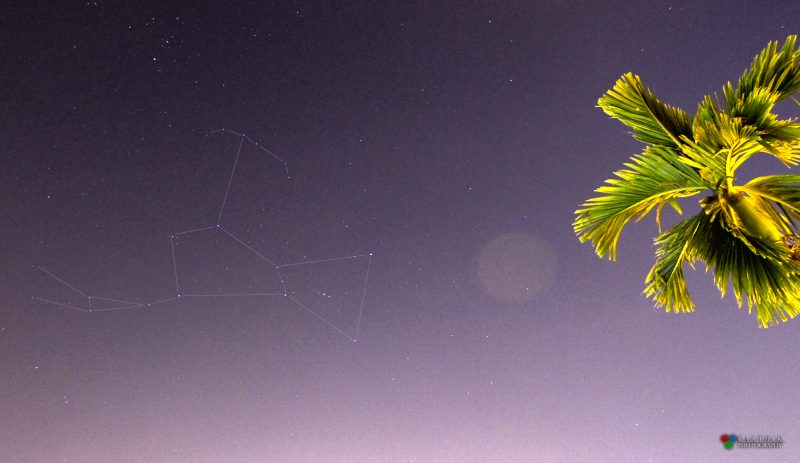
Karthik Easvur caught the constellation Orion on November 26, 2016, from his balcony in Hyderabad, India. The round translucent object in the photo, by the way, is a lens flare – an internal reflection from Karthik’s camera – likely caused by the same artificial light that’s illuminating the palm tree on the right.
Bottom line: By mid-to-late November, the famous constellation Orion the Hunter is back in the evening sky! Its most recognizable feature is called Orion’s Belt: a short, straight line of three medium-bright stars.
EarthSky astronomy kits are perfect for beginners. Order today from the EarthSky store
Donate: Your support means the world to us
from EarthSky https://ift.tt/2DKFoYT

Tonight, watch for Orion the Hunter, perhaps the easiest to identify of all constellations, with its three medium-bright Belt stars in a short, straight row. By mid-to-late November, famous Orion is back in the evening sky, rising at mid-evening (about midway between your local sundown and midnight). It’s around late November and early December that casual skywatchers will begin to notice Orion and to comment on it. You can find this constellation and watch it for months to come.
Plus there’s a binocular comet in the sky – within Orion – that you might be able to glimpse. It’ll be closest to Earth on November 14, 2020. Read more about Comet C/2020 M3 (Atlas).
The most noticeable part of Orion is Orion’s Belt. These three stars in a row aren’t the brightest in the sky, but they’ll catch your eye. As seen from mid-northern latitudes, Orion appears to be lying on his side – with his Belt stars pointing upward – when he first ascends into our eastern sky in mid-evening at this time of year. Orion’s two brightest stars – Betelgeuse and Rigel – shine on opposite sides of the Belt.
EarthSky 2021 lunar calendars are available! They make great gifts. Order now. Going fast!

Stars trails of constellation Orion via EarthSky Facebook friend Jean-Baptiste Feldmann. Can you pick out the three stars in Orion’s Belt? Notice also the different colors of the stars in Orion.
As night passes, and Earth spins beneath the sky, Orion will climb higher in our sky. When this constellation is highest in the south, it is a huge, noticeable star pattern. But Orion doesn’t reach its highest point until an hour or two after midnight (that’s local time, for all times zones around the world) in mid- to late November.
Like all the stars, Orion’s stars rise some four minutes earlier with each passing day, or about two hours earlier with each passing month. If you see Orion shining in the east at 9 p.m. tonight, look for Orion to be in the same place in the sky at about 7 p.m. a month from now. Or if Orion is due south at 2 a.m. tomorrow, look for Orion to be due south at midnight one month later.

This chart shows the famous constellation of Orion the Hunter. From northerly latitudes in the Northern Hemisphere, Orion stands upright in the southern sky (as pictured above) when this constellation reaches its highest point for the night. From temperate latitudes in the Southern Hemisphere, however, Orion is seen “upside-down” in the northern sky when the Hunter reaches its highest point for the night.
This shift in Orion’s location is due to Earth’s movement in orbit around the sun. As we move around the sun, our perspective on the stars surrounding us shifts. At the same hour daily, all the stars in the eastern half of the sky climb up a bit higher, whereas all the stars in the western half of the sky sink a bit closer to the western horizon.

Mirror view of Orion the Hunter from Johannes Hevelius' Uranographia (1690).
Are you familiar with the W- or M-shaped constellation Cassiopeia the Queen? Or Polaris, the North Star? As Orion rises in the east this evening, look for Cassiopeia to soar to her highest point for the night, above Polaris in the northern sky.

Karthik Easvur caught the constellation Orion on November 26, 2016, from his balcony in Hyderabad, India. The round translucent object in the photo, by the way, is a lens flare – an internal reflection from Karthik’s camera – likely caused by the same artificial light that’s illuminating the palm tree on the right.
Bottom line: By mid-to-late November, the famous constellation Orion the Hunter is back in the evening sky! Its most recognizable feature is called Orion’s Belt: a short, straight line of three medium-bright stars.
EarthSky astronomy kits are perfect for beginners. Order today from the EarthSky store
Donate: Your support means the world to us
from EarthSky https://ift.tt/2DKFoYT

Aucun commentaire:
Enregistrer un commentaire